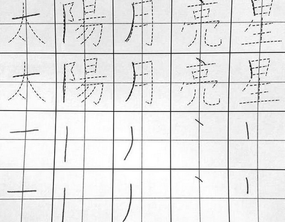
Above: Some children might copy words one stroke at a time in attempt to finish the copying task more quickly. However, this does not help children to learn ultimately.
Prescribed methods of teaching new characters almost always require children to copy them multiple times. Is this an effective learning strategy? We suspect that copying does help children, but it is more effective and more helpful for older children in middle primary school and above, than it is for kindergartners. Have you ever seen your child or your student write one stroke at a time, repeating the same individual stroke across all ten boxes in which the character is to be copied, and then go back to write the second stroke for all ten, and so on? Many children who are writing mindlessly sometimes do this just to get it done. That is, instead of writing the whole character stroke by stroke to practice it, they write one stroke of the character across all the blank boxes and then return to do the next stroke for all ten. They do this because it seems like less work to finish the homework. This strategy may help them to finish up the homework more quickly, but it does not help them ultimately to learn. This phenomenon underscores the fact that to young children, copying sometimes seems completely meaningless.
In our research with kindergartners, we find that copying is most effective when children's attention is simultaneously drawn to the meaningful parts within the character. For example, when parents or teachers emphasize the individual radicals that are being written with the stroke sequences and what these radicals mean and how they support the meaning of the whole character, learning is enhanced. It is much better to tell a story about the character and only have the child write the character once or twice than it is to have the child write the character ten times without any explanation as to what he or she is doing or why.
For older children, copying is very important for learning. There is the visual-motor aspect of writing of Chinese that is effectively reinforced via copying. This becomes automatic, just as tying our shoes, though it requires a series of steps and sequencing when we are first learning, after awhile can be done almost without thinking or attention to each step (i.e., stroke). Even in young children, copying should be part of learning, but the number of times the child should be asked to copy each character can probably be reduced from what is typical now, perhaps down from ten to two or three, with more attention to each step and why it is important. Chinese writing practice, when introduced in an interesting way, can engage children's skill set on so many levels.